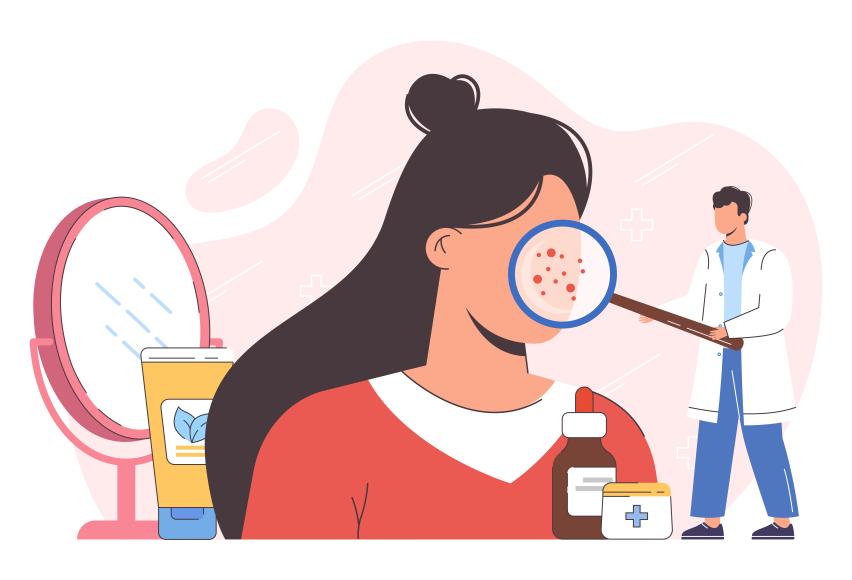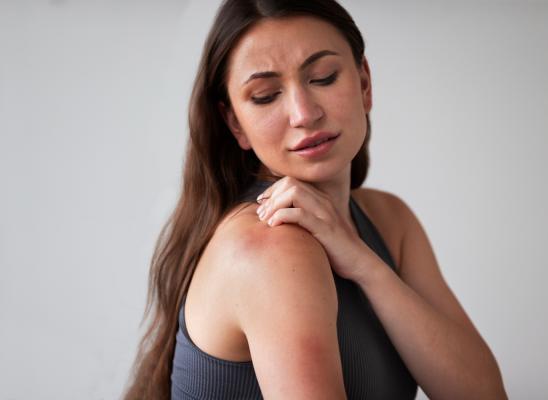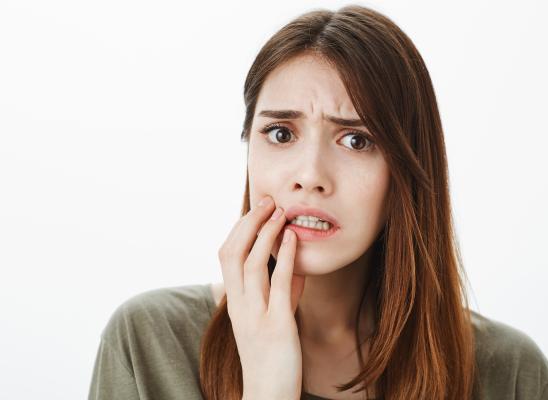Beyond Subtypes: Classifying Skin Picking Behaviors

Online test
Find out the severity of your symptoms with this free online test
Excoriation Disorder, commonly referred to as skin picking disorder, is a body-focused repetitive behavior (BFRB) characterized by compulsive picking at the skin resulting in tissue damage, emotional distress, and impaired functioning. It is a highly heterogenous disorder, meaning that people pick in different ways and for different reasons.
Research has identified two main subtypes of skin picking – focused and automatic picking.
- In focused picking, the person is acutely aware of and intentional in their picking. Focused picking seems to occur as a response to a specific trigger such as intense urges to feel certain emotions either during or after the act or to relieve an intense physical sensation such as itching. Once started, it is difficult to stop.
- In automatic picking, picking is an automatic, unconscious behavior. It is sometimes referred to as if the person is in a trance. The person may not even know that they’ve picked their skin until the episode is complete. This type of picking seems to be done to regulate internal stimuli such as emotions and thoughts.
While some people may fall completely into one subtype or the other, many people experience both types of picking to varying degrees. A substantial number of people with a BFRB also have one or more mental health issues that have implications for their experience. Treatment outcomes are highly variable, and some people respond better to treatment than others. Just why that happens isn’t entirely clear.
A new study suggests that skin picking may not be an “either/or” type of picking but rather it occur along a spectrum based on its extent and severity. Viewing skin picking as occurring along a spectrum, rather than simply “excoriation” behavior may offer a more useful and supportive way of approaching treatment. Where a person falls along that spectrum and the degree to which their picking interferes with functioning and emotional well-being determines the need for intervention.
Defining Types of Picking
Using the current DSM 5 criteria for excoriation disorder and a review of the literature, this new study proposes a classification of skin picking behaviors for diagnosing and treating skin picking. The picking types are based on diagnostic criteria and factors such as etiology, emotional states, and other relevant considerations. They assert that an organized conceptualization of skin picking offers a more constructive approach to care, enhancing the likelihood of successful treatment outcomes.
The Organic and Dysesthetic Picker
The organic or dysesthetic picker’s behavior occurs in response to itchiness, dysesthesia (unusual touch-based sensations), or some disease process such as thyroid dysfunction. Treatment would depend on further investigation of symptoms and underlying medical or dermatological findings.
The Obsessive-Compulsive Picker
Obsessive compulsive disorder (OCD) is characterized by repetitive, intrusive thoughts that lead to compulsive behaviors. An obsessive-compulsive picker tends to be preoccupied with intrusive thoughts and compulsions surrounding the picking behavior. Picking may be an attempt to alleviate distressing emotions. The picking and the inability to control the urges can increase agitation.
The Habit/Functionally Autonomous Picker
Unlike the OCD picker, the habit picker has no associated obsessive and intrusive thoughts or ritualistic behaviors. Rather, they tend to pick mindlessly. This form of picking tends to be less severe than some other forms. Picking may have developed over time as a way of self-soothing but became habitual over time.
The Anxious/Depressed Picker
A significant percentage of people with skin picking also have a comorbid anxiety or depressive disorder. Emotional dysregulation has been associated with skin picking and research suggests individuals with deficits in emotional regulation respond to distress in ways that relieve the emotional distress and also reinforce the behavior.
The Attention Deficit Hyperactivity Disorder (ADHD) Picker
Some evidence suggests that there is an association between ADHD and skin picking. ADHD can co-occur with skin picking and it is thought that the symptoms of ADHD – inattention, hyperactivity, and impulsivity – may influence skin picking. There is also some evidence to suggest that they may have similar underlying processes. Certain medications to treat ADHD seem to help reduce skin picking behavior.
The Borderline Picker
Borderline personality disorder (BPD) is disorder characterized by unstable interpersonal relationships, poor self-image, and poor emotional regulation. One of the clinical features of BPD is self-injurious behaviors. It is not uncommon for people with BPD to have other co-occurring mental health disorders, including skin picking.
The Narcissistic Picker
A narcissistic personality disorder is characterized by an exaggerated sense of self-importance, a high need for attention and admiration, and a lack of empathy for others. This type of picker may be preoccupied with appearance and beauty. There is no tolerance for perceived imperfections and may pick in an effort to achieve perfection.
The Body Dysmorphic Picker
A person with body dysmorphic disorder (BDD) is overly focused on perceived defects in their physical appearance and will engage in repetitive behaviors, like skin picking, to try and correct them. Skin picking is a common feature of BDD, but they are distinct disorders. Unlike the narcissistic picker who comes from a place of inflated self-importance, the picker with BDD generally has more a negative view of the self and body image.
The Delusional Picker
A delusion is an unshakable belief in something that isn’t true. People with DI have a belief that their body is infested with some parasite or fiber or has something coming out of their skin. An example of that might be Delusional infestation (DI). DI is generally presents as secondary to a primary psychiatric disorder such as an anxiety disorder, OCD, or schizophrenia. While it can affect anyone, it is most often seen in postmenopausal women. There is some evidence that DI may be related to dopamine dysregulation in the brain. Skin picking has also been associated with dopamine regulation.
The Guilty Picker
Guilt and shame are common themes associated with skin picking. For the guilty picker, picking is related to feelings of guilt, fear, remorse, and self-loathing in response to actual or perceived indiscretions. Picking can be without conscious purpose or may be more intentional. may occur in the service of knelling dysesthesias (especially in the Asking for help can be particularly difficult for this group.
The Angry Picker
Anger is often referred to as a secondary emotion and used as a cover or protection from expression more vulnerable emotions like fear or hurt, humiliation or rejection. We often feel other emotions before expressing fear. The angry picker may not be aware that their picking is a manifestation of anger. Their picking may be an attempt to alleviate some underlying emotion or need.
What This Means for Skin Picking Treatment
While this is one attempt at classification, studies like this one speak to the need to consider a more holistic, individualized approach to care. Skin picking can occur and by influenced by a number of factors, each needing consideration when designing a care plan. Some picking types may respond better to Habit Reversal Training (HRT) while others may need an enhanced approach that addresses both the cognitive and behavioral aspects of picking. As always, tailoring treatment to the person rather than the disorder means a greater likelihood of treatment success.
References
1. Parsa, L., Pixley, J. N., & Fried, R. G. (2023). "Pick" wisely: An approach to diagnosis and management of pathologic skin picking. Clinics in dermatology, 41(1), 41–48. https://pubmed.ncbi.nlm.nih.gov/36878452/
2. Roberts, S., O'Connor, K., Aardema, F., Bélanger, C., & Courchesne, C. (2016). The role of emotion regulation in body-focused repetitive behaviours. The Cognitive Behaviour Therapist, 9, E7. https://www.cambridge.org/core/journals/the-cognitive-behaviour-therapist/article/abs/role-of-emotion-regulation-in-bodyfocused-repetitive-behaviours/8E267245687F7D75A63ED2B2214482D1
3. Grant, J. E., & Chamberlain, S. R. (2020). Prevalence of skin picking (excoriation) disorder. Journal of psychiatric research, 130, 57–60. https://www.ncbi.nlm.nih.gov/pmc/articles/PMC7115927/
4. Yurteri, N., & Sarıgedik, E. (2020). Skin Picking Successfully Treated With Atomoxetine in Comorbid Skin Picking and Attention-Deficit/Hyperactivity Disorder: A Case Report. Clinical neuropharmacology, 43(4), 114–115. https://pubmed.ncbi.nlm.nih.gov/32541332/
5. Okan Ibiloğlu, A., Atli, A., Kaya, M. C., Demir, S., Bulut, M., & Sir, A. (2016). A Case of Skin Picking Disorder of a Patient with a History of Childhood Abuse. Noro psikiyatri arsivi, 53(2), 181–183.https://www.ncbi.nlm.nih.gov/pmc/articles/PMC5353026/
6. Delusions of parasitosis - StatPearls - NCBI bookshelf. (2023, May 22). National Center for Biotechnology Information. https://www.ncbi.nlm.nih.gov/books/NBK541021/
7. Anderson, S., Clarke, V., & Thomas, Z. (2022). The problem with picking: Permittance, escape and shame in problematic skin picking. Psychology and Psychotherapy: Theory, Research and Practice, 96(1), 83-100. https://bpspsychub.onlinelibrary.wiley.com/doi/10.1111/papt.12427
Online test
Find out the severity of your symptoms with this free online test
Start your journey with SkinPick
Take control of your life and find freedom from skin picking through professional therapy and evidence-based behavioral techniques.
Start Now



